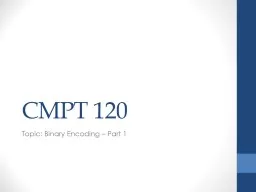

Topic Binary Encoding Part 1 Learning Outcome At the end of this course a student is expected to Manipulate binary encodings of simple data types Do conversions from binary system to ID: 557301
Download Presentation The PPT/PDF document "CMPT 120" is the property of its rightful owner. Permission is granted to download and print the materials on this web site for personal, non-commercial use only, and to display it on your personal computer provided you do not modify the materials and that you retain all copyright notices contained in the materials. By downloading content from our website, you accept the terms of this agreement.
Slide1
CMPT 120
Topic:
Binary Encoding – Part 1Slide2
Learning Outcome
At
the end of this course, a student is expected to:
Manipulate binary encodings of simple data types.Do conversions from binary system to decimal and vice versaDetermine the range of representable values within binary systemDo additions and incremental counting within binary systemDecode/encode a bit string to/from its corresponding value (unsigned, 2's complement, ASCII)
2Slide3
Last Few Lectures
Iterative
Statements
while
loop
for
loop
range( ) built-in functionin operatorAlgorithms commonly used in CSRunning a count, running a sum, running a productComputing an averageBuilding a sequenceLooking for the maximum/minimumnumber occurrences of a specific element in a sequence
3Slide4
Today’s Menu
Binary
encoding
How characters are represented in memoryBinary and decimal numeral systemsIncremental counting and adding in those numeral systemsConverting binary numbers <-> decimal numbers
4
Binary
numeral
systemOctal numeral systemDecimal numeral system
Hexadecimal
numeral
systemSlide5
So far, we have seen that …
Computer memory
10010011101001000100010001000100010001000110001
0010101010100010010010010001000100110010001011011100100100100100100100000000110010100101010101000100100100100010001001100100010110111001001011101001010101010001001011000010100010011001000101101110010010101
010010010010010101001
integer
f
loating point
number
character
CPU instruction
colour
sound
5Slide6
Binary numeral system
We have already mentioned that
Computer
hardware functions using two voltage levelsSee link Computers and Voltage Levels in Week 2We represent these two voltage levels using 0’s and 1’s 0’s and 1’s are the 2 symbols of the binary numeral systemUsing binary numeral system makes talking about computer hardware (CPU architecture, CPU instruction set, memory content etc
…)
easier
As our previous slide demonstrated, what a sequence of 0’s and 1’s represent depends on the context, i.e. the
application that uses the information6Slide7
How is data
represented
in the computer memory?CharacterKey pressed on the keyboardCharacter represented by the key is mapped to a sequence of 8 bits in the ASCII section of the UNICODE table (see next slide) These 8 bits are then stored in computer memoryExample:What is ASCII?What is UNICODE?(see link on our course web site)
7Slide8
N
umeral
representation of
characterSource: http://www.hki.uni-koeln.de/sites/all/files/courses/5514/1000px-ASCII-Table.jpg
8Slide9
Source: http
://1.bp.blogspot.com/_e8aZh22zXKM/TMeR_fFL8aI/AAAAAAAAAAo/pIR08vVLkz0/s320/Hello_World.jpg
Example - Numerical representation of character
Padding: 9Slide10
What happens when we compare strings?
As we have already seen, Python compares strings by using the numerical representation of each character
For example:
Does “banana” come before or after “apple”, i.e., “banana” < “apple”?How humans answer the question:How a computer answer the question:
10Slide11
Numeral systems
As we saw in our ASCII table, a number can be expressed in a variety of numeral systems
For example:
Binary numeral system
Octal numeral
system
Decimal numeral
systemHexadecimal numeral system
11Slide12
Decimal numeral system
Deci
mal -> 10 (Base 10)
Ten digits: When counting: 12Slide13
Decimal numeral system
When adding:
13Slide14
Binary numeral system
Bin
ary -> 2 (Base 2)
Two digits:When counting:14Slide15
Binary numeral system
When adding
:
15Slide16
Convert binary to decimal
First, let’s examine how we
read numbers
expressed in the decimal numeral systemConsider the positional value of each digit in the decimal number below 2501416Slide17
Convert binary to decimal
Applying the same
algorithm
, let’s convert the following number expressed in binary numeral system to its equivalent in decimal numeral system 0110000117Slide18
Convert decimal to binary
We could use a table and map the binary number to its decimal equivalent like we did when we mapped characters to their ASCII value equivalent
18Slide19
Convert decimal to binary
Applying the same
algorithm as the one described in our reading
, let’s convert the following number expressed in decimal numeral system to its equivalent in binary numeral system 21319Slide20
Summary
In terms of Learning Outcomes
At
the end of this course, a student is expected to:Manipulate binary encodings of simple data types.Do conversions from binary system to decimal and vice versaDetermine the range of representable values within binary systemsDo additions and incremental counting within binary systemsDecode/encode a bit string to/from its corresponding value (unsigned, 2's complement, ASCII)
20Slide21
Next Lecture
21
Binary
encodingHow integers are represented in memoryUnsignedSignedSign and magnitude1’s complement2's complement
How
floating point numbers
are represented in memoryHow many values (range) can they represent